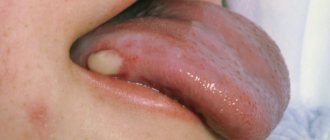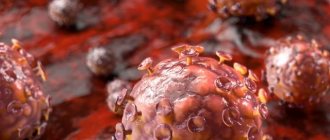Tongue cancer is a fairly common pathology in the structure of malignant neoplasms of the head and neck organs (about 55% of cases), and in the general structure of malignant neoplasms it accounts for 0.45%. The average age of those affected is 60 years, men suffer from it 3 times more often than women. But the tumor can also occur in young people and even children.
- Causes of tongue cancer
- Symptoms of tongue cancer
- Methods for diagnosing tongue cancer
- Treatment of tongue cancer
- Prevention
Most often, cancer is localized on the lateral surface, a little less often on the root of the tongue, and very rarely in the area of its back and tip. [1,2]
Anatomical structure of the tongue
Varieties
There are two main classifications of tongue tumors: according to the form of the disease and according to histological structure. Let's look at them.
The forms of tongue cancer are as follows:
- Ulcerative . With this form, an ulcerated, bleeding tumor is found on the tongue.
- Papillary . A dense growth forms on the tongue on the so-called “pedicle” or on a wide base.
- Infiltrative . The tumor is located deep within the organ.
Classification according to histological structure:
- adenocarcinoma;
- squamous cell carcinoma (the most common - 95% of cases);
- basal cell.
General information
A malignant neoplasm in the tongue comes from the mucosal epithelium.
Despite the fact that tongue tumors are uncommon, they have an aggressive course, so early detection is important. Distinctive features of this disease are early metastasis (including distant), rapid growth, resistance to treatment, high recurrence rate and mortality. At the time of diagnosis, half of the patients had affected regional lymph nodes. Recurrence is observed in 30-50% of patients. If we consider the localization, then most often a tumor of the tongue occurs on the lateral surface, much less often there is cancer of the root of the tongue, the back and the tip. A neoplasm of the root of the tongue is classified as oropharyngeal cancer. The asymptomatic course of the disease makes early diagnosis difficult. Tumors are either not visible in the early stages or initial changes are regarded as a consequence of trauma to the tongue. Due to the lack of alertness of patients and doctors regarding malignant neoplasms, most cases are diagnosed with a full clinical picture or already in an advanced stage.
The highest incidence is observed after 50 years of age, but this disease also occurs in people under 30 years of age. In men, this pathology is diagnosed 5 times more often. In 95% of cases, tongue tumors are squamous cell carcinoma. Squamous cell carcinoma of the tongue is an aggressive tumor and insensitive to treatment ( chemotherapy ), but radiation treatment .
Symptoms
Symptoms vary depending on the stage of the disease. The first signs at the initial stage:
- feeling of tongue numbness;
- discomfort in the oral cavity;
- wounds that do not heal for a long time;
- a red or white spot on the tongue.
Further, when the stage becomes later, or advanced, patients note the following signs of the disease:
- ulcers that do not heal for a long time;
- voice change;
- enlarged lymph nodes in the neck;
- excessive salivation;
- disturbance of movements of the lower jaw.
Late stages of tongue tumor development are characterized by symptoms such as:
- difficulty swallowing;
- persistent severe pain in the mouth, radiating to the neck, throat, temples, ear;
- bleeding in the mouth in the absence of injury;
- bad breath associated with the destruction of soft tissues.
When a tumor metastasizes and spreads to other organs, the symptoms are as follows:
- nausea;
- weakness, fatigue;
- causeless weight loss;
- specific signs that an organ, such as the liver or lungs, is affected.
Chemotherapy
Chemotherapy is the use of drugs that have the ability to inhibit tumor growth. In modern realities, we often talk about polychemotherapy - the simultaneous use of several drugs with different mechanisms of action.
When treating oral cancer, self-administered chemotherapy is used only for palliative purposes to relieve the symptoms of the disease. At the same time, the side effects of chemotherapy require an individual and balanced approach to deciding whether it is appropriate. Partial regression can be obtained in 25-40% of cases with an expected life expectancy of 6-10 months.
The main place of chemotherapy is its combination with radiotherapeutic treatment, mainly as part of adjuvant chemoradiotherapy.
Diagnostics
To accurately diagnose tongue cancer, laboratory and hardware tests are required. However, first of all, the patient should consult an ENT oncologist, who will give the necessary directions. Among the diagnostic methods:
- blood for tumor markers, other laboratory blood tests;
- biopsy of the affected area followed by histological examination;
- revision (revision) of the biopsy;
- MRI of soft tissues of the neck and face using contrast;
- CT scan of the neck and head with contrast;
- PET-CT.
Prognosis for tongue cancer
After completing a treatment course at different stages of cancer, it is customary to take into account the average statistical prognosis based on five-year survival. Naturally, this process is strictly individual for each patient and depends on a number of objective and subjective factors.
Nowadays, when starting cancer treatment abroad, patients always consult their doctor about the prognosis for a particular case. For example, by the localization of the tumor process in the tongue, it is possible to predict the further development of the disease and find the most appropriate options for effective therapy. Timely diagnosis and combined treatment of tongue cancer make the patient’s recovery expected and predictable.
Methods of treating the disease
Treatments for this type of cancer include surgery, radiation therapy, and chemotherapy. Let's consider these methods separately.
Surgery
The main method of treatment is resection (removal) of the tumor. The principle of the surgical technique is to remove a malignant tumor from the patient. Surgery is always performed, except in cases where the tumor is inoperable.
Operation options:
- Gentle resection, in which the tongue or most of it is preserved.
- Radical removal (the operation is called glossectomy, this is the total removal of the tongue).
- Together with glossectomy or after it, reconstruction of the tongue is often performed - one-stage plastic surgery with a skin flap. This intervention allows you to preserve the functions of the removed organ.
Radiation therapy
Radiation is designed to destroy cancer cells or slow their growth. For small tumors this is the main treatment method. Radiation can also be given before surgery (to reduce the tumor) and after it (to avoid relapse). In later stages, the technique is used as palliative therapy, that is, it alleviates symptoms.
Chemotherapy
This is a systemic therapy that aims to destroy malignant cells throughout the body. Chemotherapy is given before surgery (to shrink the tumor) or after it (to avoid relapse).
Diet
Diet for tongue cancer
- Efficacy: therapeutic effect for a month
- Timing: constantly
- Cost of products: 1300-1500 rubles per week
Difficulties with swallowing in the patient before and after surgery force the installation of a nasoesophageal tube. Through it, broth with meat and eggs beaten in a blender, sour cream, cream and other high-calorie liquid products are introduced. A nutritional mixture must be prescribed in addition to the main diet . This is a liquid high-calorie and high-protein mixture enriched with micronutrients. This can be Nutrizon Advance , Nutrizon Protein Advance , Nutrizon Energy , Nutrizon Protein Intense , Supportan Mixture for enteral nutrition, Fresubin original , Fresubin Energy , Nutricomp . With the transition to natural nutrition, a diet table with liquid dishes is organized - puree soup, boiled fish and meat (veal), poultry (turkey, chicken), whipped in a blender, meat and fish soufflé, liquid omelet, yoghurt, milk, cauliflower, broccoli in the form of mashed potatoes, mashed potatoes.
Stages of the disease
Stages of tongue cancer
We offer you a table of correspondence between tongue tumor stages and clinical TNM classification, which uses the following designations:
- T – indicates the primary tumor: Tx – the primary tumor cannot be assessed;
- T0 – no data on the primary tumor;
- Тis – cancer in situ (pre-invasive stage);
- T1-T4 – the primary tumor is enlarged and/or widespread.
- Nx – regional lymph nodes cannot be assessed;
- M0 – no distant metastases;
Correspondence table for stages of tongue cancer TNM classification
| TNM stage | |
| 0 (carcinoma in situ) | Tis, N0, M0 |
| I | T1, N0, M0 |
| II | T2, N0, M0 |
| III | T3, N0, M0 or T1-T3, N1, M0 |
| IV | 4a: T4a, N0 M0 or T4aN1, M0 or T1-T4a, N2, M0 4b: T4b, any N, M0 or any T, N3, M0 4c: any T, any N, M1 |
Reviews
16.11.2021
Oncology clinic NACFF. The real story about “not giving a damn”
In 2022, on August 16, my older sister flew to Lobnya to undergo examination and, if necessary, treatment at the NACFF oncology clinic.
She lives in the capital Kyrgyzstan...
Read full review
27.10.2021
At the clinic, like at home
30.09.2021
Feedback on the treatment of ovarian cancer at the NACFF clinic
07.09.2021
NACFF patient about treatment, quick examinations and attentive attitude
View all reviews
Hospital, hospitalization, emergency medical care - 24/7, 7 days a week
+7 (495) 259-44-44
Reasons for appearance
There are a number of predisposing factors to the development of tongue cancer. Let's look at them in more detail:
- Tobacco and alcohol . When smoking, the risk of developing this disease is influenced by how much, often and for how long a person smokes. Those who have been diagnosed with this type of cancer need to completely stop smoking, since continued tobacco use increases the risk of developing cancer of another location. Of 10 patients with malignant neoplasms of the oral cavity, 7 are susceptible to alcohol dependence. The combination of alcohol and smoking increases the risk of oral cancer by 100 times compared to people who do not drink or smoke.
- Human papillomavirus (HPV) . The incidence of oral cancers associated with HPV has increased in the last decade. According to research, cancer associated with HPV affects mainly young patients who do not have a long history of drinking alcohol and smoking. Now many doctors associate the prevalence of HPV in the last two decades with people's passion for oral sex.
- Floor . Men suffer from this type of cancer 2 times more often than women, which may be due to frequent consumption of alcoholic beverages and smoking.
- Age . Oral cancer is more often diagnosed in patients 55-60 years old. This is due to its slow development. However, the presence of HPV changes this situation.
- Poor nutrition . According to several studies, the risk of developing such cancer increases with a deficiency of vegetables and fruits in the diet.
- Weak immune system . The risk increases in people who have congenital or acquired immunodeficiency, as well as in those who take drugs to suppress the immune system (this is necessary after an organ transplant).
- Graft versus host disease (GVHD) . This reaction is typical for the condition after stem cell transplantation: this is how the body reacts to foreign donor cells. Oral cancer can develop within 2 years.
- Lichen planus. This disease most often affects the surface of the skin, but can also appear as white spots and lines on the oral mucosa. Increases the risk slightly.
- Bowen's disease. This is an obligate precancerous condition, the tumor is located inside the epithelial layer. Sooner or later it transforms into malignant.
Book your room today
6 seats
1 local ward
- 4 meals a day
- Bathroom in the room
- Anti-decubitus mattresses
8200 rub.
Book
13 places
2 local ward
- 4 meals a day
- Bathroom in the room
- Anti-decubitus mattresses
5700 rub.
Book
2 seats
VIP chamber
- a guest room
- 4 meals a day
- Bathroom in the room
- Anti-decubitus mattresses
17700 rub.
Book
6 seats
1 local ward
- 4 meals a day
- Bathroom in the room
- Anti-decubitus mattresses
8200 rub.
Book
13 places
2 local ward
- 4 meals a day
- Bathroom in the room
- Anti-decubitus mattresses
5700 rub.
Book
2 seats
VIP chamber
- a guest room
- 4 meals a day
- Bathroom in the room
- Anti-decubitus mattresses
17700 rub.
Book
Observation
After treatment, you need to undergo regular examinations, their frequency depends on how many years have passed since entering remission.
- In the 1st year - every 1-3 months.
- In the 2nd year - every 2-6 months.
- In 3-5 years - every 4-8 months.
- In the 6th year and thereafter – annually.
The following manipulations and examinations are carried out as control tests:
- medical instrumental examination of the oral cavity, peripheral lymph nodes;
- examination by a dentist if radiation therapy was performed in the oral cavity;
- endoscopic examination of the pharynx and oral cavity;
- for patients who have previously smoked - MRI (CT) of the soft tissues of the neck with contrast, CT of the chest and abdominal cavity with contrast. If necessary, PET with glucose, osteoscintigraphy.
Prevention
The following are called preventive measures:
- Regular visits to the dentist - once every six months.
- Constant inspection of the tongue for strange formations.
- Elimination of traumatic factors. If there is an interfering filling in the mouth or the dentures do not fit well, this must be corrected.
- Quitting bad habits: alcohol, cigarettes.
- Timely treatment of all problems in the oral cavity.
- General strengthening of the immune system.
People who are attentive to oral hygiene, as a rule, notice the first signs of tongue cancer earlier than others and consult a dentist in time for initial diagnosis.










